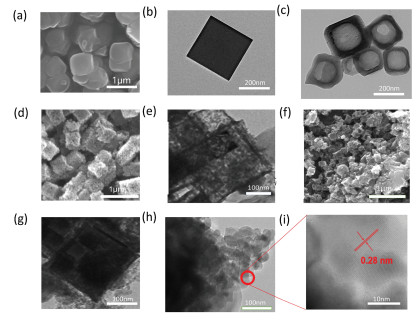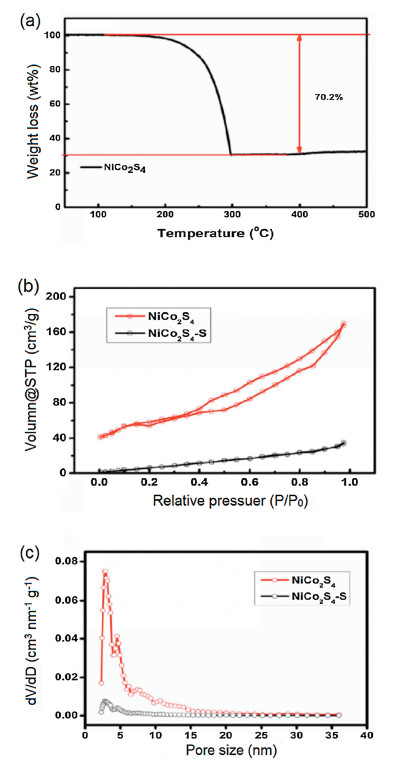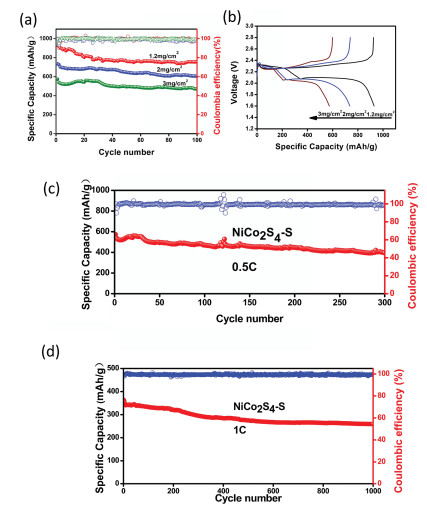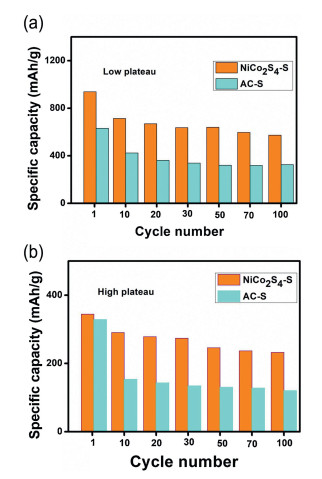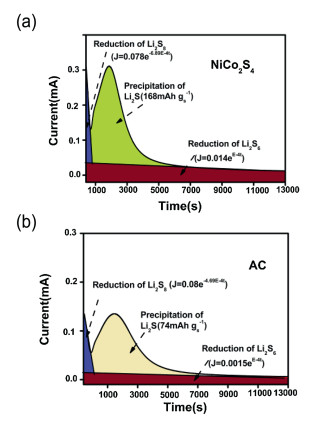-
[1]
Goodenough, J. B. Evolution of strategies for modern rechargeable batteries. Accounts of Chemical Research 46, 1053–1061 (2013).
doi: 10.1021/ar2002705
-
[2]
Choi, J. W. & Aurbach, D. Promise and reality of post-lithium-ion batteries with high energy densities. Nature Reviews Materials 1, 16013 (2016).
doi: 10.1038/natrevmats.2016.13
-
[3]
Tang, Y., Zhang, Y., Li, W., Ma, B. & Chen, X. Rational material design for ultrafast rechargeable lithium-ion batteries. Chemical Society Reviews 44, 5926–5940 (2015).
doi: 10.1039/C4CS00442F
-
[4]
Li, H., Sun, L., Zhang, Y.G. et al. Enhanced cycle performance of Li/S battery with the reduced graphene oxide/activated carbon functional interlayer. Journal of Energy Chemistry 26, 1276–1281 (2017).
doi: 10.1016/j.jechem.2017.09.009
-
[5]
Liu, Y. T., Han, D.D., Wang, L. et al. NiCo2O4 Nanofibers as Carbon-Free Sulfur Immobilizer to Fabricate Sulfur-Based Composite with High Volumetric Capacity for Lithium–Sulfur Battery. Advanced Energy Materials 9, 1–10 (2019).
-
[6]
Manthiram, A., Chung, S. -H. & Zu, C. Lithium-Sulfur Batteries: Progress and Prospects. Advanced Materials 27, 1980–2006.
-
[7]
Lin, C., Niu, C.J., Xu, X. et al. A facile synthesis of three dimensional graphene sponge composited with sulfur nanoparticles for flexible Li–S cathodes. Physical Chemistry Chemical Physics 18, 22146–22153 (2016).
-
[8]
Li, F., Zhou, G.M., Pei, S.F. et al. A graphene-pure-sulfur sandwich structure for ultrafast, long-life lithium-sulfur batteries. Advanced Materials 26, 625–631 (2014).
doi: 10.12785/amis/080220
-
[9]
Tang, X., Sun, Z., Yang, H. et al. Electrochemical process of sulfur in carbon materials from electrode thickness to interlayer. Journal of Energy Chemistry 31, 119–124 (2019).
doi: 10.1016/j.jechem.2018.06.001
-
[10]
Liang, Z. Zheng, G.Y. Li, W.Y. et al. Sulfur Cathodes with Hydrogen Reduced Titanium Dioxide Inverse Opal Structure. ACS Nano 8, 5249–5256 (2014).
doi: 10.1021/nn501308m
-
[11]
Song, J., Gordin, M., Xu, T. et al. Strong Lithium Polysulfide Chemisorption on Electroactive Sites of Nitrogen-Doped Carbon Composites For High-Performance Lithium-Sulfur Battery Cathodes. Angewandte Chemie International Edition 54, 4325–4329 (2015).
doi: 10.1002/anie.201411109
-
[12]
Rehman, S., Gu, X., Khan, K. et al. 3D Vertically Aligned and Interconnected Porous Carbon Nanosheets as Sulfur Immobilizers for High Performance Lithium-Sulfur Batteries. Advanced Energy Materials 6, 1502518 (2016).
doi: 10.1002/aenm.201502518
-
[13]
Zhou, X., Chen, F. & Yang, J. Core@shell sulfur@polypyrrole nanoparticles sandwiched in graphene sheets as cathode for lithium-sulfur batteries. Journal of Energy Chemistry 24, 448–455 (2015).
doi: 10.1016/j.jechem.2015.06.011
-
[14]
Zhuang, X., Liu, Y., Chen, J., Chen, H. & Yi, B. Sulfur/carbon composites prepared with ordered porous carbon for Li-S battery cathode. Journal of Energy Chemistry 23, 391–396 (2014).
doi: 10.1016/S2095-4956(14)60162-5
-
[15]
Wang, D., Wang, K., Wu, H. et al. CO2 oxidation of carbon nanotubes for lithium-sulfur batteries with improved electrochemical performance. Carbon 132, 370–379 (2018).
doi: 10.1016/j.carbon.2018.02.048
-
[16]
Yuan, Z., Peng, H., Huang, J. et al. Electrodes: Hierarchical Free-Standing Carbon-Nanotube Paper Electrodes with Ultrahigh Sulfur-Loading for Lithium-Sulfur Batteries (Adv. Funct. Mater. 39/2014). Advanced Functional Materials 24, 6244–6244 (2014).
-
[17]
Sun, Q., Fang, X., Weng, W. et al. An Aligned and Laminated Nanostructured Carbon Hybrid Cathode for High-Performance Lithium-Sulfur Batteries. Angewandte Chemie 127, 10685–10690 (2015).
doi: 10.1002/ange.201504514
-
[18]
Li, Z., Zou, Y., Duan, J., Long, B. & Du, Y. Long-cycle stability for Li-S batteries by carbon nanofibers/reduced graphene oxide as host cathode material. Ionics 25, 1659–1668 (2019).
doi: 10.1007/s11581-019-02897-7
-
[19]
Li, F., Su, Y. & Zhao, J. Shuttle inhibition by chemical adsorption of lithium polysulfides in B and N co-doped graphene for Li–S batteries. Physical Chemistry Chemical Physics 18, 25241–25248 (2016).
doi: 10.1039/C6CP04071C
-
[20]
Zhang, H., Gao, Q., Qian, W. et al. Binary Hierarchical Porous Graphene/Pyrolytic Carbon Nanocomposite Matrix Loaded with Sulfur as a High-Performance Li–S Battery Cathode. ACS Applied Materials & Interfaces 10, 18726–18733 (2018).
doi: 10.1021/acsami.8b03806
-
[21]
Qiu, Y., Li, W., Li, G. et al. Polyaniline-modified cetyltrimethylammonium bromide-graphene oxide-sulfur nanocomposites with enhanced performance for lithium-sulfur batteries. Nano Research 7, 1355–1363 (2014).
doi: 10.1007/s12274-014-0500-5
-
[22]
Zhou, W., Wang, C., Zhang, Q. et al. Tailoring Pore Size of Nitrogen-Doped Hollow Carbon Nanospheres for Confining Sulfur in Lithium-Sulfur Batteries. Advanced Energy Materials 5, 1401752 (2015).
doi: 10.1002/aenm.201401752
-
[23]
Nersisyan, H., Joo, S., Yoo, B. et al. Combustion-mediated synthesis of hollow carbon nanospheres for high-performance cathode material in lithium-sulfur battery. Carbon 103, 255–262 (2016).
doi: 10.1016/j.carbon.2016.03.022
-
[24]
Chen, M., Su, Z., Jiang, K. et al. Promoting sulfur immobilization by a hierarchical morphology of hollow carbon nanosphere clusters for high-stability Li–S battery. Journal of Materials Chemistry A 7, 6250–6258 (2019).
doi: 10.1039/c8ta12349g
-
[25]
Zhang, Q., Wang, Y., Seh, Z. et al. Understanding the Anchoring Effect of Two-Dimensional Layered Materials for Lithium–Sulfur Batteries. Nano Letters 15, 3780–3786 (2015).
doi: 10.1021/acs.nanolett.5b00367
-
[26]
Li, S. Y., Wang, W. P., Duan, H. & Guo, Y. G. Recent progress on confinement of polysulfides through physical and chemical methods. Journal of Energy Chemistry 27, 1555–1565 (2018).
doi: 10.1016/j.jechem.2018.04.014
-
[27]
Seh, Z. W., Li, W., Cha, Z. et al. Sulphur-TiO2 yolk-shell nanoarchitecture with internal void space for long-cycle lithium-sulphur batteries. Nature Communications 4, (2013).
doi: 10.1038/ncomms2327
-
[28]
Xiao, Z., Yang, Z. Wang, L. et al. A Lightweight TiO2 /Graphene Interlayer, Applied as a Highly Effective Polysulfide Absorbent for Fast, Long-Life Lithium-Sulfur Batteries. Advanced Materials 27, 2891–2898 (2015).
doi: 10.1002/adma.201405637
-
[29]
Yuan, Z., Pemg, H., Hou, T. et al. Powering Lithium–Sulfur Battery Performance by Propelling Polysulfide Redox at Sulfiphilic Hosts. Nano Letters 16, 519–527 (2016).
doi: 10.1021/acs.nanolett.5b04166
-
[30]
Seh, Z. W., Yu, J., Li, W. et al. Two-dimensional layered transition metal disulphides for effective encapsulation of high-capacity lithium sulphide cathodes. Nature Communications 5, 5017 (2014).
doi: 10.1038/ncomms6017
-
[31]
Cui, Z., Zu, C., Zhou, W., Manthiram, A. & Goodenough, J. B. Mesoporous Titanium Nitride-Enabled Highly Stable Lithium-Sulfur Batteries. Advanced Materials 28, 6926–6931 (2016).
doi: 10.1002/adma.201601382
-
[32]
Ma, L., Yuan, H., Zhang, W. et al. Porous-Shell Vanadium Nitride Nanobubbles with Ultrahigh Areal Sulfur Loading for High-Capacity and Long-Life Lithium–Sulfur Batteries. Nano Letters 17, 7839–7846 (2017).
doi: 10.1021/acs.nanolett.7b04084
-
[33]
Sun, Z., Zhang, J., Yin, L. et al. Conductive porous vanadium nitride/graphene composite as chemical anchor of polysulfides for lithium-sulfur batteries. Nature Communications 8, 1–8 (2017).
doi: 10.1038/s41467-016-0009-6
-
[34]
Liang, X., Rangom, Y., Kwok, C. Y., Pang, Q. & Nazar, L. F. Interwoven MXene Nanosheet/Carbon-Nanotube Composites as Li-S Cathode Hosts. Advanced Materials 29, 1603040 (2017).
doi: 10.1002/adma.201603040
-
[35]
Liang, X., Garsuch, A. & Nazar, L. F. Sulfur Cathodes Based on Conductive MXene Nanosheets for High-Performance Lithium-Sulfur Batteries. Angewandte Chemie 127, 3979–3983 (2015).
doi: 10.1002/ange.201410174
-
[36]
Pang, Q., Kundu, D. & Nazar, L. F. A graphene-like metallic cathode host for long-life and high-loading lithium–sulfur batteries. Materials Horizons 3, 130–136 (2016).
doi: 10.1039/C5MH00246J
-
[37]
Demir-Cakan, R., Morcrette, M., Nouar, F. et al. Cathode composites for Li-S batteries via the use of oxygenated porous architectures. Journal of the American Chemical Society 133, 16154–16160 (2011).
doi: 10.1021/ja2062659
-
[38]
Zhao, Z., Liang, H., Chen, J. et al. Graphene-wrapped chromium-MOF(MIL-101)/sulfur composite for performance improvement of high-rate rechargeable Li-S batteries. Journal of Materials Chemistry A 2, 13509–13512 (2014).
doi: 10.1039/C4TA01241K
-
[39]
Zhou, J., Li, R., Fan, X, et al. Rational design of a metal–organic framework host for sulfur storage in fast, long-cycle Li–S batteries. Energy & Environmental Science 7, 2715 (2014).
doi: 10.1039/C4EE01382D
-
[40]
Wang, Z., Dou, Z., Cui, Y. et al. Sulfur encapsulated ZIF-8 as cathode material for lithium–sulfur battery with improved cyclability. Microporous and Mesoporous Materials 185, 92–96 (2014).
doi: 10.1016/j.micromeso.2013.11.011
-
[41]
Zheng, J., Tian, J., Wu, D. et al. Lewis Acid–Base Interactions between Polysulfides and Metal Organic Framework in Lithium Sulfur Batteries. Nano Letters 14, 2345–2352 (2014).
doi: 10.1021/nl404721h
-
[42]
Lu, Y., Li, X., Liang, J. et al. A simple melting-diffusing-reacting strategy to fabricate S/NiS2 -C for lithium-sulfur batteries. Nanoscale 8, 17616–17622 (2016).
doi: 10.1039/C6NR05626A
-
[43]
Hong, X., Li, S., Tang, X., Sun, Z. & Li, F. Self-supporting porous CoS2/rGO sulfur host prepared by bottom-up assembly for lithium-sulfur batteries. Journal of Alloys and Compounds 749, 586–593 (2018).
doi: 10.1016/j.jallcom.2018.03.331
-
[44]
Chen, T., Zhang, Z., Cheng, B. et al. Self-Templated Formation of Interlaced Carbon Nanotubes Threaded Hollow Co3S4 Nanoboxes for High-Rate and Heat-Resistant Lithium-Sulfur Batteries. Journal of the American Chemical Society 139, 12710–12715 (2017).
doi: 10.1021/jacs.7b06973
-
[45]
Dai, C., Lin, J., Wang, W. et al. Honeycomb-Like Spherical Cathode Host Constructed from Hollow Metallic and Polar Co9S8 Tubules for Advanced Lithium-Sulfur Batteries. Advanced Functional Materials 28, 1704443 (2018).
doi: 10.1002/adfm.201704443
-
[46]
Chen, T., Ma, L., Cheng, B. et al. Metallic and polar Co9S8 inlaid carbon hollow nanopolyhedra as efficient polysulfide mediator for lithium−sulfur batteries. Nano Energy 38, 239–248 (2017).
doi: 10.1016/j.nanoen.2017.05.064
-
[47]
Cong, X., Cheng, C., Liao, Y. et al. Intrinsic Charge Storage Capability of Transition Metal Dichalcogenides as Pseudocapacitor Electrodes. The Journal of Physical Chemistry C 119, 20864–20870 (2015).
doi: 10.1021/acs.jpcc.5b07004
-
[48]
Wu, L., Tang, S. & Qu, R. Urchin-like NiCo2S4 infused sulfur as cathode for lithium–sulfur battery. Journal of Materials Science: Materials in Electronics 30, 189–199 (2019).
doi: 10.1007/s10854-018-0281-9
-
[49]
Yang, Y., Cheng, D., Chen, S., Guan, Y. & Xiong, J. Construction of Hierarchical NiCo2S4@Ni(OH)2 Core-Shell Hybrid Nanosheet Arrays on Ni Foam for High-Performance Aqueous Hybrid Supercapacitors. Electrochimica Acta 193, 116–127 (2016).
doi: 10.1016/j.electacta.2016.02.053
-
[50]
Chen, H., Jiang, J., Zhang, L. et al. In situ growth of NiCo2S4 nanotube arrays on Ni foam for supercapacitors: Maximizing utilization efficiency at high mass loading to achieve ultrahigh areal pseudocapacitance. Journal of Power Sources 254, 249–257 (2014).
doi: 10.1360/132013-185
-
[51]
Zhu, Y., Ji, X., Wu, Z. & Liu, Y. NiCo2S4 hollow microsphere decorated by acetylene black for high-performance asymmetric supercapacitor. Electrochimica Acta 186, 562–571 (2015).
doi: 10.1016/j.electacta.2015.10.176
-
[52]
Zhao, M.Y., Zhu, L., Fu, B. et al. Sodium ion storage performance of NiCo2S4 hexagonal nanosheets. Acta Physico-Chimica Sinica 35, 193-199(2019).
doi: 10.3866/pku.whxb201801241
-
[53]
Chen, H., Ma, X., Shen, P. K. et al. NiCo2S4 nanocores in-situ encapsulated in graphene sheets as anode materials for lithium-ion batteries. Chemical Engineering Journal 364, 167-176(2019).
doi: 10.1016/j.cej.2019.01.119
-
[54]
Chuan, X., Peng, L., Appala N.G. et al. Is NiCo2S4 really a semiconductor? Chemistry of Materials 27, 6482-6485 (2015).
doi: 10.1021/acs.chemmater.5b01843
-
[55]
Fan, Q., Liu, W., Weng, Zh. et al. Ternary Hybrid Material for High-Performance Lithium-Sulfur Battery. Journal of the American Chemical Society 137, 12946-12953 (2015).
doi: 10.1021/jacs.5b07071
-
[56]
Liu, B., Huang, S., Kong, D., Hu, J. & Yang, H. Y. Bifunctional NiCo2S4 catalysts supported on a carbon textile interlayer for ultra-stable Li-S battery. Journal of Materials Chemistry A 7, 7604–7613 (2019).
doi: 10.1039/c9ta00701f
-
[57]
Chiochan, P., Phattharasupakun, N., Wutthiprom, J. et al. Core-double shell sulfur@carbon black nanosphere@oxidized carbon nanosheet composites as the cathode materials for Li-S batteries. Electrochimica Actav 237, 78-86 (2017).
doi: 10.1016/j.electacta.2017.03.199
-
[58]
Yang, W., Yang, W., Feng, J. & Qin, X. A polypyrrole-coated acetylene black/sulfur composite cathode material for lithium–sulfur batteries. Journal of Energy Chemistry 27, 813–819 (2018).
doi: 10.1016/j.jechem.2017.05.007
-
[59]
Tong, W., Huang, Y., Jia, W. et al. Leaf-like interconnected network structure of MWCNT/Co9S8/S for lithium-sulfur batteries. Journal of Alloys and Compounds 731, 964-970 ((2017).
-
[60]
Shen, J., Liu, J., Liu, Z. et al. Nanoconfined Oxidation Synthesis of N‐Doped Carbon Hollow Spheres and MnO 2 Encapsulated Sulfur Cathode for Superior Li‐S Batteries. Chemistry – A European Journal 24, 4573–4582 (2018).
doi: 10.1002/chem.201704590
-
[61]
Tan, X., Wang, X., Wang, X. et al. NiCo2S4 yolk-shell hollow spheres with physical and chemical interaction toward polysulfides for advanced lithium-sulfur batteries. Ionics 25, 4047 (2019).
doi: 10.1007/s11581-019-02969-8
-
[62]
Lu, X., Zhang, Q., Wang, J. et al. High performance bimetal sulfides for lithium-sulfur batteries. Chemical Engineering Journal 358, 955–961 (2019).
doi: 10.1016/j.cej.2018.10.104
-
[63]
Zhenzhen, L., Lei, Zh., Qi, G. et al. Atomic iron catalysis of polysulfide conversion in lithium–sulfur batteries. ACS Applied Materials & Interfaces 10 (23), 19311-19317 (2018).
doi: 10.1021/acsami.8b03830
-
[64]
Kong, L., Chen, X., Li, B. ‐Q., et al. A bifunctional perovskite promoter for polysulfide regulation toward stable lithium–sulfur batteries. Adv. Mater. 30, 1705219-1705225(2018).
doi: 10.1002/adma.201705219

 Login In
Login In

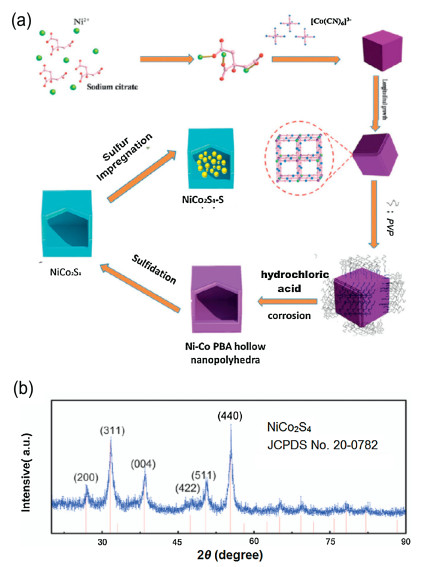





 DownLoad:
DownLoad:
